The next-gen MacBook Pro with Retina Display Review
by Anand Lal Shimpi on June 23, 2012 4:14 AM EST- Posted in
- Mac
- Apple
- MacBook Pro
- Laptops
- Notebooks
General Performance
The Retina MacBook Pro can complete a full boot from power off to usable desktop in just over 17 seconds. It’s a hair faster than last year’s MacBook Airs, a bit quicker than the old SSD equipped MacBook Pro, and night and day compared to any Mac with a hard drive. Four years ago I said that Solid State Drives were the single biggest upgrade you could do for your computer, and it couldn’t be any more true today.
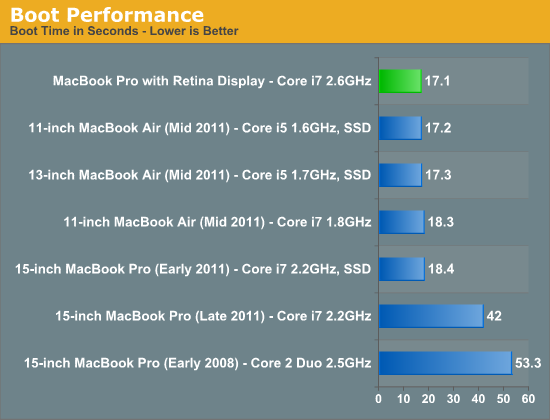
The Retina MBP behaves more like the 3rd gen MacBook Air in how it goes to sleep and wakes up. Both happen virtually instantaneously, and if your battery dies while asleep you don’t get the greyed out screen with progress bar as your environment is restored from disk - it just appears, taking a couple of seconds for the clock to update and everything else to come to life. It’s a small but subtle change that tells you the rMBP is in a distinctly different class. Apple’s tight control over firmware and storage interface help it deliver up to 30 days of standby power, a number I’ll really need to verify one of these days.
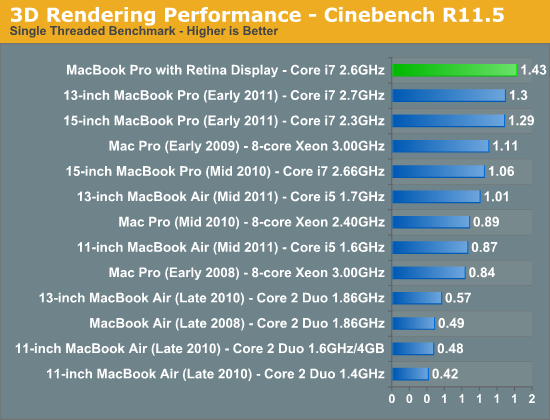
Raw CPU performance is up handsomely over the 2011 MacBook Pros, at least in their standard configurations. The 2.6GHz chip in the $2799 rMBP can turbo up to 3.6GHz when only a single core is active, delivering a 13% increase in performance over the previous generation 2.2GHz part. Compared to the upgraded 2.4GHz Sandy Bridge Core i7 from last year (not pictured) however, I would expect a sub-10% advantage.
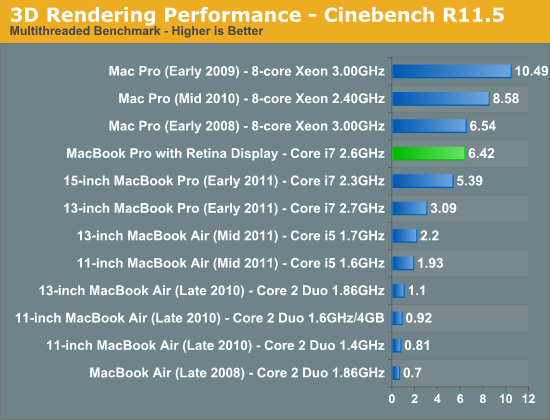
With all four cores active the 2.6GHz chip can run at up to 3.4GHz, which it regularly hits as long as the Kepler GPU stays asleep. The 2.2GHz Sandy Bridge based 2011s we’re comparing to on the other hand can only turbo up to 2.8GHz. Here the advantage is a more tangible 19%, although once again if you are comparing to one of the 2.4GHz parts from last year I would expect notably smaller gains (mid to high single digit percentages). The improved thermal characteristics may allow mobile Ivy Bridge to operate in turbo modes for longer than Sandy Bridge, however I don’t have any data to actually support that claim. That doesn’t mean it can’t happen, it’s just complex to test and model.
While the Cinebench tests are largely CPU bound, many of the following tests are largely influenced by the SSD in the Retina MacBook Pro. Here we see some huge gains, especially compared to older HDD based Macs.
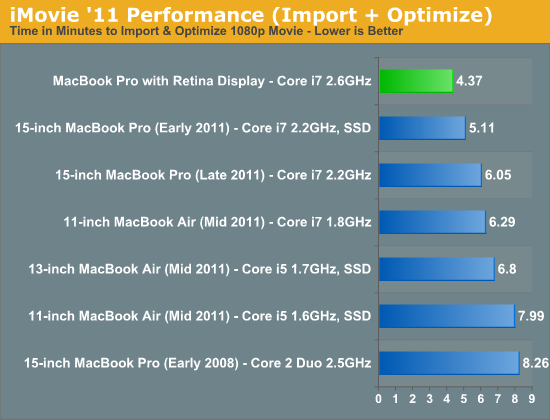
iMovie import time is heavily influenced by disk as well as CPU performance. As a result there are big improvements over both the HDD and SSD equipped 2011 MBPs.

Export time is more heavily CPU bound and here the advantage over the previous generation notebooks is pretty much nonexistent.
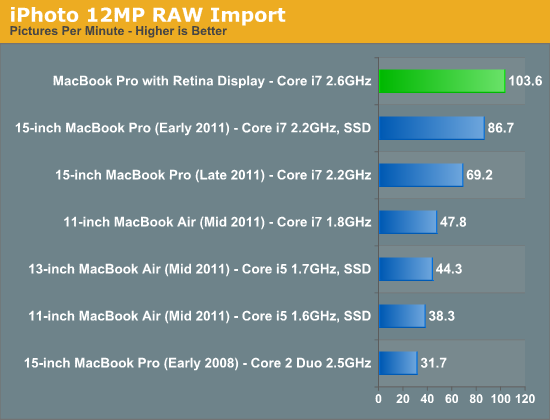
Our iPhoto import test stresses both disk and CPU, giving the rMBP a tangible advantage compared to the SSD equipped 2011 MBP. None of the dual-core or HDD based Macs stand a chance here.

Our Lightroom test continues the storage/CPU dependencies as only the SSD equipped 2011 MBP is able to come close to the rMBP’s performance. There’s not much of a performance advantage here when you compare similarly equipped systems though. Ivy Bridge may have been a good upgrade from a power standpoint, but it doesn’t tell a significantly different performance story in all cases.
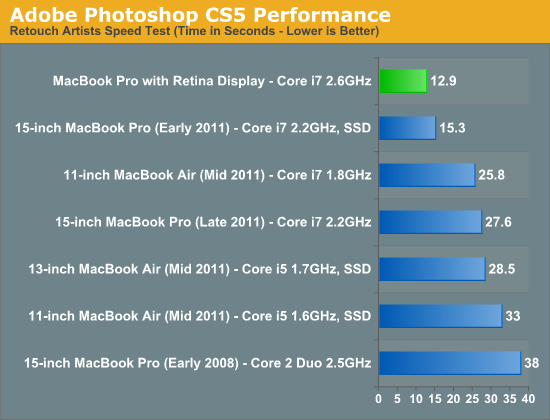
The rMBP cranks through our Photoshop workload fairly quickly. The performance advantages here are likely due to increased memory, a much faster SSD and obvious CPU speed improvements as well.
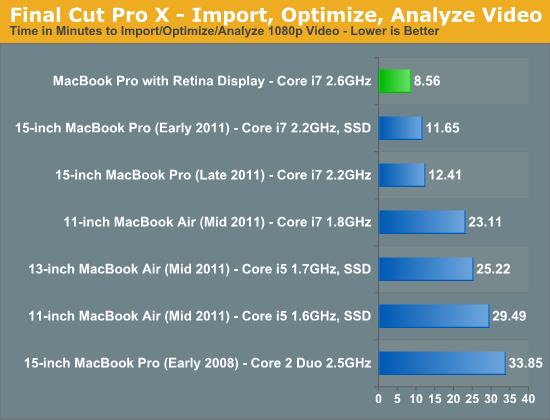
The same holds true for the advantages in our Final Cut Pro X test. As a default configuration the $2799 MacBook Pro with Retina Display is easily the fastest notebook Apple has ever shipped. It’s only if you had an upgraded 2011 model (perhaps with an aftermarket SSD?) that you’ll be unimpressed by the move.
I can’t stress enough how much the new SSD improves the overall experience. It’s just so much faster than what Apple used to ship.










471 Comments
View All Comments
orthorim - Wednesday, June 27, 2012 - link
A very high resolution display is not a retina display - totally different thing.Retina is a special mode where each logical pixel is made up of 4 physical pixels, and special support for fonts and images.
It's a huge step to go from 1:1 logical : physical pixels to a different factor. It's like bitmap based fonts vs. points-based vector fonts.
Maybe a lot of PC manufacturers just don't get that?
vegemeister - Monday, July 2, 2012 - link
Apple is not using a PPI independent UI for their high-res displays though. There's a separate set of assets at 2x resolution, and programs that don't acknowledge that they're rendering at 2x resolution get upscaled.A real PPI independent UI, such as Gnome 2, uses vector resources for everything and allows applications to query the PPI of the display so they can render at appropriate dimensions.
maraboshi - Saturday, June 30, 2012 - link
and still that was FAIL because it runs Windows and not a brilliant OS like the Apple one...when will you stupid Apple haters will understand the fucking difference?????gbanfalvi - Sunday, July 1, 2012 - link
I have it. It's a piece of crap. It feels like they just stuffed everything they could in this device without thinking.The pads on the bottom fell of from the heat.
The battery died seven months in.
The trackpad starts glitching regularly (not to mention it's terrible in general).
The 1080p screen gets lines across it.
The laptop overheats when I put it in speed mode.
Evidence: https://dl.dropbox.com/u/245279/Photos/Photo%20201...
azaat07 - Friday, July 13, 2012 - link
Hole in your hyperbole...Only option is Intel Graphics 4000, shared memory.
Intel 4k graphics are on par with 2007 discrete.
Andrew
woodsielord - Sunday, July 15, 2012 - link
I have the said computer. I bought it with very high expectations, and the screen is still amazing, but the rest of the hardware keeps causing trouble. I have lived without my computer 3+ months due to repairs, and currently I'm typing this from my girlfriend's Zenbook (which, on the other hand, is zero problems and all play).The lack of international Sony support and the proclimity to hardware failure rule out Sony of all my future purchases. Many times I said to myself that I should have bought a MBP instead. If Sony stopped spewing forth so many products and instead tended to the details of flagship products and cared about its customers, it might have worked.
mark3785 - Saturday, September 8, 2012 - link
Ok, I'll play the fanboy…This is where Apple haters really get pissed (and as an Apple fan from the mid 80s (and a loyalist from the 90 days from bankruptcy days) (if I'm playing the fanboi thing I may as well go whole hog) I really start to chuckle).
The MacBook Pro with retina display is proof positive that Apple can do things that the windows community can't because Apple has control of both sides of the coin, the hardware and the OS, plus (and this is a really huge plus) they have some very smart people working for them. It's one thing to put a hires display on a computer and an entirely different thing to make that display resolution independent. Sony may have come out with a hires laptop back in 2010, but they didn't do anything interesting with it.
Eventually 2880x1800 will be run of the mill and higher resolutions will start to dominate. It isn't the number of pixels, it's how the system uses them to it's best advantage. This is (hopefully) the beginning of a new trend.
BTW, one helluva review! Reviews are boring, though comforting when they state the obvious (yes, you bought a nifty machine, pat on the head) but a review this informative and complete just reinvigorates my interest in the hobby.
Targon - Saturday, June 23, 2012 - link
You need to look at the different price points that machines are sold for before you make statements like that. Most manufacturers see far greater volumes in the $500 range than they see in the $1500+ range, and it is that range that the majority of consumers look when it comes to buying a computer, either desktop or laptop.The area that manufacturers SHOULD be moving in is to make the move to a 1920x1080 display across their entire range of 14 inch and greater machines as the norm, rather than as an extra feature that people need to pay extra for if you are in the $450+ price range. Higher resolutions should be offered as the norm for higher end laptop displays. Until that happens, the PC side of the industry will seem to be inferior when it comes to display technology.
If you think about it, display technologies have been fairly stagnant except from Apple, and we have not seen an aggressive attempt to improve what we see out there. 1920x1080 displays have been the norm for too long, and going to 1920x1200 isn't enough.
OCedHrt - Sunday, June 24, 2012 - link
Check out the new Sony TTvegemeister - Monday, July 2, 2012 - link
1920x1080 should be the norm for 11".